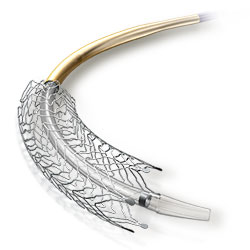
Excellent precision, flexibility, and proven clinical results1 in the iliacs.



| Lengths (mm) | |||||||
|---|---|---|---|---|---|---|---|
| 20 | 30 | 40 | 60 | 80 | 100 | ||
| Stent Diameter (mm) | 6.0 | 6F/8F | 6F/8F | 6F/8F | 6F/8F | 6F/8F | 6F/8F |
| 7.0 | 6F/8F | 6F/8F | 6F/8F | 6F/8F | 6F/8F | 6F/8F | |
| 8.0 | 6F/8F | 6F/8F | 6F/8F | 6F/8F | 6F/8F | 6F/8F | |
| 9.0 | 6F/8F | 6F/8F | 6F/8F | 6F/8F | 6F/8F | 6F/8F | |
| 10.0 | 6F/8F | 6F/8F | 6F/8F | 6F/8F | 6F/8F | 6F/8F | |
| Sheath/Guide Compatibility | |||||||
Data on file at Abbott.
*Combined clinical results from BRAVISSIMO study where 54%/46% of TASC D lesions were treated with Absolute Pro™ Vascular Self-Expanding Stent System / Omnilink Elite™ Vascular Balloon-Expandable Stent System respectively.
MAT-2114527 v1.0

The Absolute Pro™ Vascular Self-Expanding Stent System is indicated for improving luminal diameter in patients with de novo or restenotic atherosclerotic lesions in the native common iliac artery and native external iliac artery with reference vessel diameters between 4.3 mm to 9.1 mm and lesion lengths up to 90 mm.
There are no known contraindications.
DO NOT USE IF THE TEMPERATURE INDICATOR IS BLACK.
This device is intended for single-use only; do not reuse. Do not resterilize. Do not use if the package is open or damaged.
Use prior to the “Use By” date specified on the package.
Persons with known hypersensitivities to nitinol and / or its components (e.g. nickel, titanium) may suffer an allergic reaction to this implant.
The safety and effectiveness of multiple overlapping stents have not been established. However, when multiple stents are required, stent materials should be of similar composition.
Stenting across a major bifurcation may hinder or prevent future diagnostic or therapeutic procedures.
Use of an undersized guide wire, with insufficient support, may cause kinking in the Stent Delivery System.
Use of appropriate anticoagulant and/or antiplatelet therapy per standard of care is recommended for use with this stent system.
Do not attempt to pull a partially-expanded stent back through the introducer sheath or guiding catheter. The stent is not designed for recapturing. The stent is not designed for repositioning once the stent has apposed the vessel. Once the stent is apposed to the vessel, it is not recommended to remove the stent with the Delivery System.
Should unusual resistance be felt at any time during lesion access or removal of the Delivery System post stent implantation, the entire system should be removed together with the introducer sheath or guiding catheter as a single unit. Failure to follow these instructions could result in failure to deploy, difficulties with deployment, partial stent deployment or deployment in an unintended location.
When removing the Delivery System as a single unit:
Failure to follow these steps and / or applying excessive force to the Delivery System can potentially result in loss or damage to the stent and / or Delivery System components.
Magnetic Resonance Imaging (MRI)
Non-clinical testing has demonstrated that the Absolute Pro Stent in single and in overlapped configurations up to 190 mm in length is MR Conditional as defined in ASTM F2503. For placement in the iliac artery, patients with this implant may be scanned safely anytime after implantation under the following conditions:
The Absolute Pro™ stent should not migrate in this MRI environment. Magnetic force on the Absolute Pro stent was tested according to ASTM F2052-06e. Non-clinical testing at field strengths greater than 3 Tesla has not been performed to evaluate stent migration or heating.
Stent heating during MRI was derived by using the measured non-clinical, in vitro temperature rise according to ASTM F2182-09 in a GE Signa HDx 3 Tesla scanner and in a GE 1.5 Tesla coil in combination with the calculated local specific absorption rates (SARs) in a digitized human model. For the SAR conditions above, the greatest in-vivo temperature rise was calculated to be 5.3°C at 128 MHz for a stent length of 60 mm. The calculations do not take into consideration the cooling effects of blood flow, and therefore, actual in-vivo rises are expected to be lower.
The effects of MRI on overlapped stents greater than 190 mm in length or stents with fractured struts are unknown. Image artifact may be present when scanning the Absolute Pro stent as demonstrated in non-clinical testing performed according to ASTM F2119-07 in a GE Signa HDx 3 Tesla scanner. The image artifact (both inside and outside the device lumen) extends approximately 5 mm from the device using the spin echo sequence and 10 mm from the device using the gradient echo sequence. MR image quality may be compromised if the area of interest is in the exact same area, or relatively close to, the position of the Absolute Pro stent. Therefore, it may be necessary to optimize the MR imaging parameters in the presence of Absolute Pro stents.
Abbott Vascular recommends that patients register the MR conditions in this IFU with the MedicAlert Foundation or equivalent organization. The MedicAlert Foundation can be contacted by phone at: (888) 633-4298, (209) 668-3333 or on the internet at www.medicalert.org.
Below is a list of the potential adverse effects (e.g., complications) that may be associated with the use of the device:
MAT-2114529 v2.0
Stay Connected